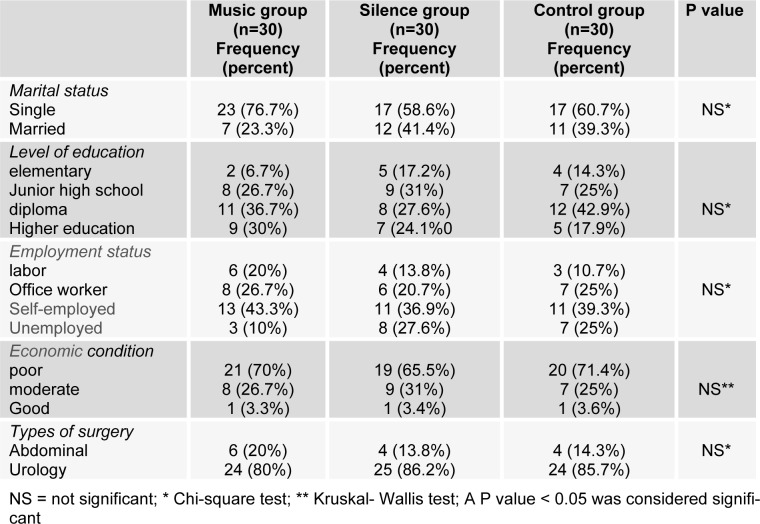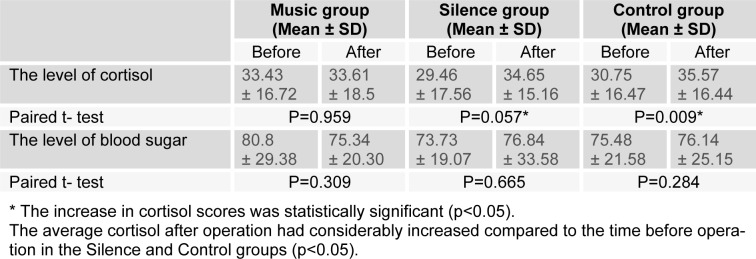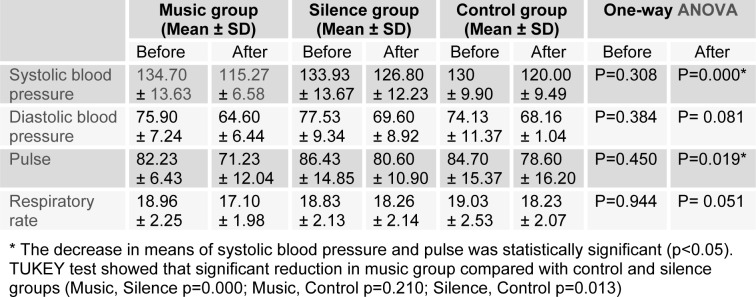Abstract
Surgical procedures performed using spinal anesthetic techniques present a special challenge to anesthesiologists, because patients are awake and are exposed to multiple anxiety provoking visual and auditory stimuli. Therefore, this study was carried out to define the effect of music on the level of cortisol, blood glucose and physiological variables in patients under spinal anesthesia.
In this semi-experimental research, 90 men aging from 18-48 years with ASA (acetylsalicylic acid) class I, who underwent urological and abdominal surgery, were investigated. Patients were divided randomly into three groups of thirty subjects. Music group (headphone with music), Silence group (headphone without music) and the control group (without interference). The level of cortisol and blood sugar was measured half an hour before and after the operation. Moreover, the physiological indicators in each of these three groups were monitored and recorded from ten minutes before getting spinal anesthesia to ten minutes after the operation.
The level of blood cortisol didn't have any increase in the music group after operation compared to the time before that. However, in the groups of silence and control this level had risen (p< 0.05). The level of blood glucose in music group had declined and in the other two groups it had increased.
Our data showed that listening to music during surgery under regional anesthesia has effects on cortisol levels and some of the physiological variables. Therefore the researcher offers to be used music therapy as a complementary method in patients on the reduce anxiety.
Keywords: music therapy, spinal anesthesia, cortisol, blood glucose, physiological variables
Introduction
Most surgical procedures are the cause of fear and anxiety leading to increase the heart rate, blood pressure and some other physiological changes in patients. These changes can hold a negative effect on the process of giving anesthesia and also the recovery period (Dunn, 2004[10]; Wakim et al., 2010[27]; Lee et al., 2011[18]). Spinal anesthesia compared to general anesthesia brings about less risk and provides sufficient level of analgesia for surgery. Making use of spinal anesthesia that is obtained through myelic nerves block in sub-archanoid space by means of local anesthetize solution, is currently increasing (Gaiser, 2005[12]). On the other hand surgical procedures that are done under spinal anesthesia bring about certain challenges for anesthetists, because patients are conscious and subject to the stress resulting from visual and auditory stimuli (Bansal et al., 2010[5]). The axis of Hypothalamus-Pituitary-Adrenal (HPA) activate in response to stress. The increase in the level of stress and anxiety in a long run can affect the function of this axis and leads to the increase in the level of cortisol in blood (Kudielka et al., 2004[16]). Cortisol is a glucocorticoid which is very functional in the metabolism of glucose, fat, and protein. Cortisol which is also named as stress hormone is a determinant in stressful situations (Koelsch et al., 2011[15]).
The rise in the level of cortisol causes the rise in the level of blood glucose and insulin resistance which consequently leads to the metabolism of proteins. A high level of blood glucose has undesirable effects on the process of wound recovery. This issue has a special significance for the patients undergoing surgical operation. High levels of cortisol would increase glomerular filtration rate and consequently would result in body's water loss and patients' dehydration. On the other hand, cortisol increases blood pressure by raising arteries' tone. A high level of cortisol impedes inflammation process, and reduces the humeral of lymphocytes which are functional in both hemoral and cellular immunity (Asghari and Lotfi Mozhgan, 2009[3]).
Anxiety affects the patient both physically and mentally and may have some undesirable effects on treatment process. It is very important that nurses consider some strategies in order to increase comfort and decrease tension and anxiety of the patients undergoing spinal anesthesia (Boudarene et al., 2002[7]).
Recorded music is a non-medicinal nursing interference that is not expensive and aggressive. Also it is without any harmful effects on patients, therefore and that can be used as a complementary method in lessening the anxiety of the patients (Stefano et al., 2004[25]; Allred et al., 2010[1]; Han et al., 2010[13]). Since music is capable of generating positive feelings and lifting people's spirits, these effects can be potentially used in clinical areas (to reduce pain and anxiety). Music may reduce the stress before, during, and after invasive procedures such as surgery, angiography and colonoscopy. It decreases the level of cortisol before, during and after such procedures as well (Koelsch et al., 2011[15]).
Pain-alleviating and stress-reducing effects of music are probably due to its potentialities in interaction procedures. These effects are attained through blocking the sounds in the operating room, lessening attractive and stressful resources as well as evincing pleasant feeling which affects the unpleasant pain resulting from operation (Koelsch et al., 2011[15]).
There have been a lot of research reports on the effect of playing music on the level of cortisol and blood glucose of the patients undergoing surgical operations, nevertheless the investigation on the effect of playing music during spinal anesthesia are limited. Leardi investigated the effect of music on the degree of stress in patients who underwent surgical operation. In this study he divided the patients into three groups. In group one, music which was chosen by the researcher was played for the patients. In group two patients themselves selected the music and for group three no interference was undertaken (music was played before and during the operation). The result of the research revealed that the level of plasma cortisol in both groups who had listened to music had declined during operation compared to the time before that but the control group manifested a rise in the level of cortisol. However there was a considerable increase in the level of cortisol after operation in group one compared to group two. The result demonstrated that when music is chosen by the patient himself, it has a greater influence on reducing cortisol (Leardi et al., 2007[17]). In 2011 Koelsch investigated the effect of music on the level of cortisol and propofol used during spinal anesthesia and the result revealed that music lowers the level of cortisol and reduces the amount of propofol used in the test group compared to the control group (Koelsch et al., 2011[15]). In 2004 Uedo et al.[26] studied the effect of music on the level of cortisol in patients who underwent colonoscopy. The outcome depicted that the rise in the level of cortisol in music was less than that of the control group. The major distinctive feature of these studies and researches is related to the fact that the studies have either been conducted with two groups involved or disregarded the effect of sound blocks in the operation room. Therefore the probability of the decline of patients' cortisol due to sound blocks in operation room can't be rejected. Considering the above mentioned evidences as well as cultural, social, economic and religious differences in Iran compared to other countries, this study was conducted with three groups involved in order to effectively and exclusively study the influence of music. This study hopes to achieve an influential breakthrough in decreasing anxiety, hormones secreted in rousing critical modes and improving physiological standards in patients undergoing spinal anesthesia.
Materials and Methods
By using a semi-experimental research design, the influence of independent variable of music on dependent variables of cortisol, blood glucose and hemodynamic condition of patients undergoing in spinal anesthesia investigated. The sample consisted of 90 men with the ASA classification I, who had candidate for urological or abdominal surgery. The sampling method was purposeful sampling. The selected subjects, then, allocated randomly in three groups. Each group consisted of 30 subjects for music group (headphone with music), silence group (headphone without music), and the control group (without manipulation). The including criteria required for getting involved in the study were: full consciousness, the ability to write and read, hemodynamic stability, no use of tranquilizers, or analgesic, no hearing disorders, no addiction to cigarette, drugs, sedatives, alcohol, no precedent for mental illness or any other related to anxiety, no precedent for surgery under spinal anesthesia. All surgical operation was in the morning. Excluded criteria included any failure during operation and anesthesia, lack of consent to continue the study and use of general anesthesia or sedative drugs during the procedure. The tools for collecting data consisted of 2 parts: the first one was the questionnaire for recording demographic specifications and the second was the checklist for recording physiological variables. Blood samples were also gathered to determine the level of cortisol and blood glucose.
On the morning of the operation in the preparatory room, patients visited and divided randomly into one of three groups. The procedures were fully defined for each patient and the written consent regarding participation in the research was taken. Before the operation, the questionnaire regarding demographic specifications was given to the patients to be filled. Half an hour before and half an hour after the operation, 2 ml venous blood was taken by the researcher to determine the level of cortisol and blood glucose. The blood samples were immediately sent to the laboratory and were centrifuged at the speed of 3500 rpm for 10 min (three samples were excluded due to spillage while they were being centrifuged and in the end 87 patients were examined). Then their plasma was separated and frozen up at the temperature of -80 °C and the level of cortisol was measured by the method of ELISA. In this investigation Diagnostics Biochem Canada (DBC) cortisol measuring kits which were made in Canada were used. To measure the level of blood glucose Pars Azmoon measuring kits were used. All patients underwent spinal anesthesia by using 2 ml Lidocaine 5 %. Normal saline or ringer was used for every patient during the operation. All patients were lying on supine position during surgery. Operation duration ranged from half an hour to one hour and if the operation lasted long (more than an hour) the sample was omitted. The vital signs were rerecorded 10 min before the operation started (as soon as the patients entered the operating room and lay on operating bed), then every 10 min during the operation and finally 10 min after the operation finished. In order to control physiological parameters of blood pressure and pulse rate the device cardio set portable patient monitor (model IX 110) was used, which was made in Iran. The respiration rate was observed and recorded by the researcher. Music was played continuously through headphone for the patients from 6 min after spinal anesthesia to 1 min before sewing up a wound (Zhang et al., 2005[28]). To treat group 1 with music therapy, the headphone and MP3 players by Marshal Company and relaxing music were used. The time of music played as well as the time and type of the operation for each patient were recorded. For group 2, headphone without music was used to block the sounds in the operation room and for the control group no interference was imposed. The relaxing music included some pieces by Johann Sebastian Bach (Pérez-Campos and Mayoral, 2010[23]). The patient had the choice to change the song and the album and also set the volume.
Statistical analysis
Data analysis was performed using the SPSS statistical package (Version 18.0). Comparison between groups was made using one-way analysis of variance (ANOVA) with TUKEY as post hoc test. Comparison before and after groups was made using Paired t- test. The comparison of physiologic variables before, during and after operation was made by Repeated Measures ANOVA. Results were reported as mean ± standard error of mean (SEM). A P value < 0.05 was considered significant.
Results
The mean age of the subjects was 23.83 ± 6.20 years. The least and the most aged were 18 and 45 years respectively. Considering the research society, the cases were homogenous in terms of marital status, employment, educational and economic conditions and the type of operation. and no significant difference was noticed (p > 0.05, Table 1(Tab. 1)). The comparison of the average level of cortisol and blood glucose among the three groups before and after interference by using one-way analysis of variance test revealed no significant difference (p > 0.05, Table 2(Tab. 2)). The comparison of the level of cortisol before and after operation in all groups was made by means of paired t-test. The result demonstrated that in music group the level of cortisol had no rise after operation compared to the time before that. Whereas in the group for whom the sounds were blocked and the control group, cortisol level had a significant increase after operation compared to the time before operation (Table 3(Tab. 3), Figure 1(Fig. 1)).
Table 1. Demographic characteristics.
Table 2. The comparison of the average cortisol and blood sugar before and after the interference in all three groups.
Table 3. The mean and standard deviation of the level of blood cortisol and blood sugar before and after interference (half an hour before and after the operation).
Figure 1. The comparison of the average level of cortisol in blood plasma before and after interference in all three groups using paired t-test.
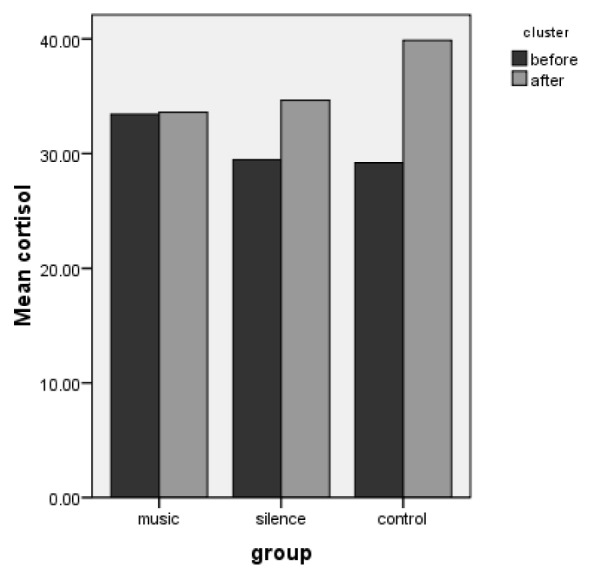
The comparison of the level of blood glucose before and after operation in all groups by making use of paired t-test depicted that in music group blood glucose had decreased after operation compared to the former time. Nevertheless this decrease was not significant. Whereas in sound block and control groups, blood glucose had risen after operation compared to the time before. This rise was not significant either (Table 3(Tab. 3), Figure 2(Fig. 2)).
Figure 2. The comparison of the average blood sugar before and after interference using paired t-test.
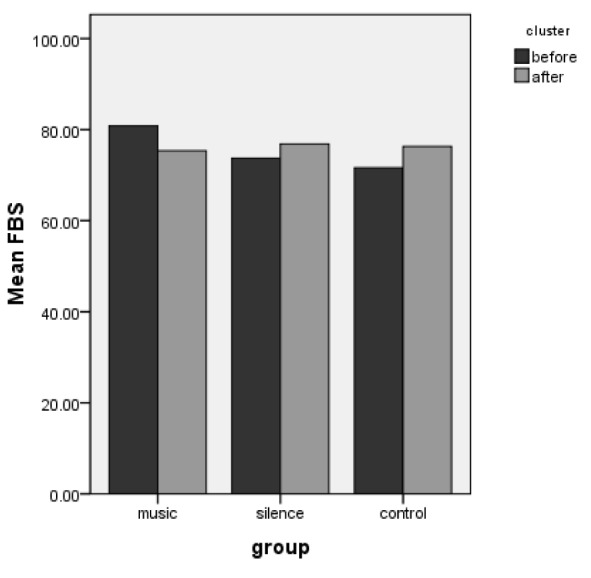
The graph above illustrates that in the music group the level of cortisol had no increase after operation compared to the time before operation, whereas in the other two groups the level of blood cortisol has increased after operation compared to before and that is a significant increase (p < 0.05).
The graph above depicts that in the music group the level of blood sugar has decreased after operation compared to the time before that. That is not a significant decrease though. The other two groups, however, revealed an increase in blood sugar after operation compared to the time before operation.
The comparison of physiologic parameters before playing music in all three groups did not show a significant difference (p > 0.05). But the average level of systolic blood pressure in all three groups was noticeably different after interference (p < 0.01). The average pulse rate was also significantly different in three groups after interference (p < 0.01). But one-way analysis of variance test didn't demonstrate a significant difference in respiration rate and diastolic blood pressure in all three groups (Table 4(Tab. 4)). The comparison of physiologic variables before, during and after operation was made by means of repeated variance analysis. Most physiologic variables except for the degree of oxygen in arterial blood followed a declining trend over a period of time. The decline in music group was more than the other two groups (Figures 3-6(Fig. 3)(Fig. 4)(Fig. 5)(Fig. 6)).
Table 4. Comparison of mean and standard deviation of pre- and postoperative physiologic variables in patients undergoing spinal anesthesia in three groups.
Figure 3. Comparison of systolic blood pressure; Repeated Measures ANOVA.
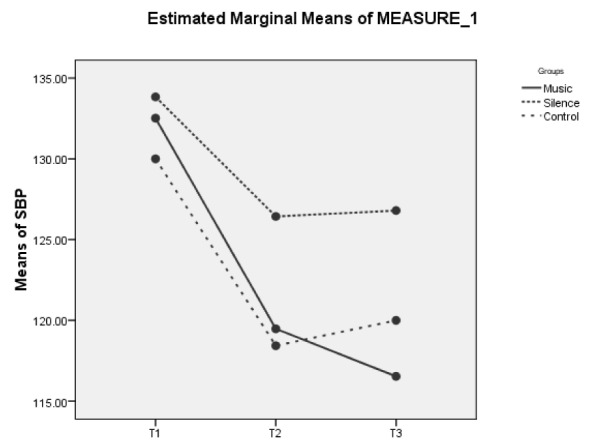
T1: pre operative; T2: intra operative; T3: post operative; SBP: Systolic Blood Pressure
Figure 4. Comparison of diastolic blood pressure; Repeated Measures ANOVA.
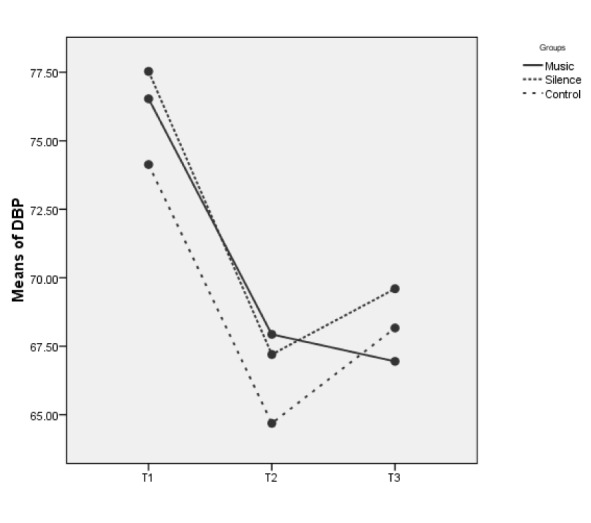
T1: pre operative; T2: intra operative; T3: post operative; DBP: Diastolic Blood Pressure
Figure 5. Comparison of pulse repeated measures ANOVA.
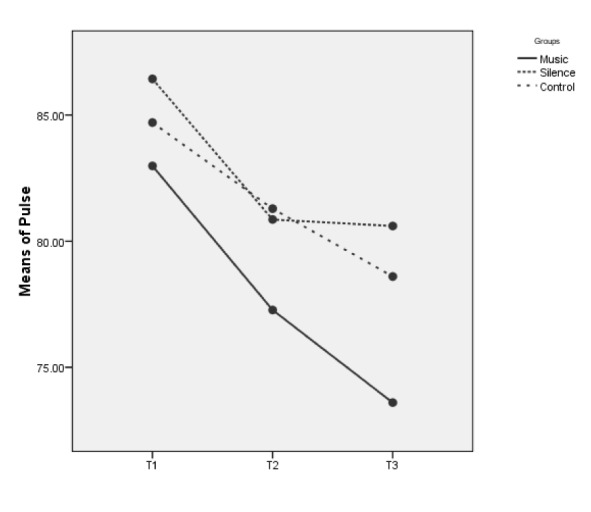
T1: pre operative, T2: intra operative; T3: post operative
Figure 6. Figure 6: Comparison of respiratory rate; repeated measures ANOVA.
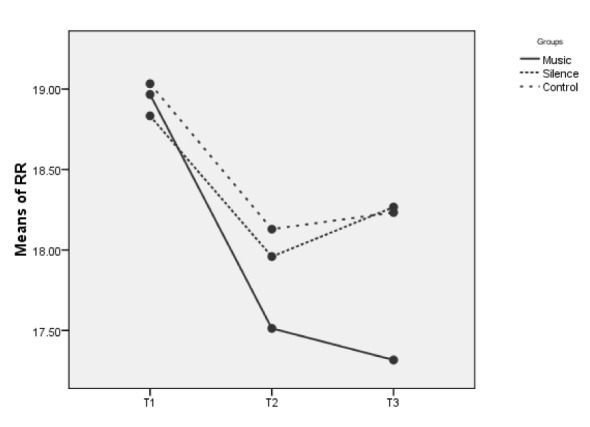
T1: pre operative, T2: intra operative; T3: post operative; RR: Respiratory Rate
Discussion
Most of the methodologies used to reduce the problems during and after operation were based on medicinal interference. In this study we have put an effort to investigate the influence of music as a cheap and non-medicinal interference on reducing the problems during and after operation. There have been a lot of researches on the influence of music as a complementary medicine; most of which lay stress on the reduction of problems and expenses of remedial treatments in the groups involved (Ayoub et al., 2005[4]; Bechtold et al., 2006[6]; Camara et al., 2008[9]; Bringman et al., 2009[8]; Engwall and Duppils, 2009[11]; Nilsson et al., 2009[22]; Makama et al., 2010[19]; Newman et al., 2010[21]; Sen et al., 2010[24]; Kim et al., 2011[14]). However the number of the studies which have investigated the influence of music on the level of blood cortisol during operation is too limited.
The results of this study indicated that the level of cortisol after operation in music group does not reveal any rise compared to the time before operation. Whereas the level of cortisol after operation in the other two groups showed a significant increase compared to the time before operation. This implies that music could prevent anxiety and in consequence the rise in the level of blood cortisol, while sound blocks in the operation room was ineffective in preventing the increase of blood cortisol. Also in the control group there was a significant rise in the level of cortisol. The study conducted by Koelsch et al. (2011[15]) to investigate the effect of music on the level of cortisol and propofol used during spinal anesthesia demonstrated that music can reduce the level of cortisol and used propofol in music group compared to control group (Koelsch et al., 2011[15]). Leardi studied the effect of music on the stress of the patients undergoing surgical operation. The results of his study displayed that music would decrease blood cortisol but the group in which the patient himself or herself had selected the music displayed a greater decrease in the level of cortisol (Leardi et al., 2007[17]).
There was also another study conducted by McRee et al. (2003[20]), which depicted that music and massage did not have any significant effect on the level of patients' cortisol. According to the writers of this article, this could arise from the time gap which was between making the interference and measuring the level of cortisol. Uedo et al. (2004[26]) inferred from their studies that the rise in cortisol in the music group had been less than that of the control group. This conclusion agrees with the present study. This very research did not reveal any considerable difference in blood glucose in all three groups before and after operation either. This implies that music does not have any significant influence on the level of blood glucose in non-diabetic patients who underwent surgical operation.
In this study music was influential in reducing systolic blood pressure during operation and also systolic blood pressure and respiration rate had not changed a lot. Bansal et al. (2010[5]) investigated the effect of music on physiological variables on the amount of tranquilizers used during spinal anesthesia. Their study revealed that music had reduced the average level of arterial blood pressure and heart beat rate in the patients in music group compared to the control group. Almerud and Petersson (2003[2]) conducted a research under the title of music therapy for the patients who were put on a ventilator in intensive care units. The results showed that the average level of systolic and diastolic blood pressure and pulse rate in the interfered group and during music therapy manifested a noticeable fall. However the average respiration rate was the same in both groups and no change was traced in the interfered group. Almerud is of the opinion that music will reduce fear and anxiety by influencing the brain and stimulating cerebral alpha waves which prompt the secretion of endorphins and cause relaxation. Endorphins secretion also reduces the physiological reactions such as the reduction in blood pressure and respiration and heart beat rate (Almerud and Petersson, 2003[2]). Considering Roy's adaption model Smolen justifies the changes made in physiological variables through listening to music and mentions that music helps patients achieve physiological adaptation to treatment situations.
The present research manifested that music therapy can bring about positive effects on patient's anxiety and some of the vital signs. Therefore it is suggested that besides other remedial methods in alleviating pain and anxiety the hospital authorities and directors profit from non-medicinal treatments such as music therapy, which at the same time are effective for vital signs and without side effects, to improve the quality of services they are offering their patients. It is also recommended that the authorities and directors of the hospitals consider music therapy as an absolutely scientific subject and ask their hospital nurses to make use of music therapy along with other effective, harmless, non-medicinal treatments to best take care of their patients.
The results of the present research revealed that music hinders the increase of blood cortisol and also improves hemodynamic condition in the patients under spinal anesthesia. Thus in regard to the advantages of music including its non-aggressive characteristics, availability, simplicity, cheap price and harmlessness (compared to medicinal treatments), it is recommended that music should be used as a complementary treatment to reduce anxiety and consequently blood cortisol during operation in patients under spinal anesthesia.
Acknowledgements
The writers of the present article express their gratitude for the respected authorities of nursing faculty of Baqiyatallah University of Medical Sciences and the authorities of educational hospitals. They also show appreciation for the family-like group of colleagues working in the above-mentioned hospitals, who made sincerely every effort to help us accomplish this research.
References
- 1.Allred KD, Byers JF, Sole ML. The effect of music on postoperative pain and anxiety. Pain Manag Nurs. 2010;11:15–25. doi: 10.1016/j.pmn.2008.12.002. [DOI] [PubMed] [Google Scholar]
- 2.Almerud S, Petersson K. Music therapy – a complementary treatment for mechanically ventilated intensive care patients. Intensive Crit Care Nurs. 2003;19:21–30. doi: 10.1016/s0964-3397(02)00118-0. [DOI] [PubMed] [Google Scholar]
- 3.Asghari KH, Lotfi Mozhgan AA. Effect of preoperative nursing visiton serum cortisol levels in patients waiting for operation: A randomized study with control group. Med J Tabriz Univ Med Sci. 2009;30:13–16. [Google Scholar]
- 4.Ayoub CM, Rizk LB, Yaacoub CI, Gaal D, Kain ZN. Music and ambient operating room noise in patients undergoing spinal anesthesia. Anesthesia & Analgesia. 2005;100:1316. doi: 10.1213/01.ANE.0000153014.46893.9B. [DOI] [PubMed] [Google Scholar]
- 5.Bansal P, Kharod U, Patel P, Sanwatsarkar S, Patel H, Kamat H. The effect of music therapy on sedative requirements and haemodynamic parameters in patients under spinal anaesthesia: a prospective study. J Clin Diagn Res. 2010;4:2782–2787. [Google Scholar]
- 6.Bechtold ML, Perez RA, Puli SR, Marshall JB. Effect of music on patients undergoing outpatient colonoscopy. World J Gastroenterol. 2006;12:7309. doi: 10.3748/wjg.v12.i45.7309. [DOI] [PMC free article] [PubMed] [Google Scholar]
- 7.Boudarene M, Legros JJ, Timsit-Berthier M. Study of the stress response: role of anxiety, cortisol and DHEAs. L'Encéphale. 2002;28:139. [PubMed] [Google Scholar]
- 8.Bringman H, Giesecke K, Thörne A, Bringman S. Relaxing music as pre medication before surgery: a randomised controlled trial. Acta Anaesthesiol Scand. 2009;53:759–764. doi: 10.1111/j.1399-6576.2009.01969.x. [DOI] [PubMed] [Google Scholar]
- 9.Camara JG, Ruszkowski JM, Worak SR. The effect of live classical piano music on the vital signs of patients undergoing ophthalmic surgery. Medscape J Med. 2008;10:149. [PMC free article] [PubMed] [Google Scholar]
- 10.Dunn K. Music and the reduction of post-operative pain. Nursing Standard. 2004;18:33–39. doi: 10.7748/ns2004.05.18.36.33.c3612. [DOI] [PubMed] [Google Scholar]
- 11.Engwall M, Duppils GS. Music as a nursing intervention for postoperative pain: a systematic review. J PeriAnesthesia Nurs. 2009;24:370–383. doi: 10.1016/j.jopan.2009.10.013. [DOI] [PubMed] [Google Scholar]
- 12.Gaiser RR. Labor epidurals and outcome. Best Practice Res Clin Anesthesiol. 2005;19:1–16. [PubMed] [Google Scholar]
- 13.Han L, Li JP, Sit JW, Chung L, Jiao ZY, Ma WG. Effects of music intervention on physiological stress response and anxiety level of mechanically ventilated patients in China: a randomised controlled trial. J Clin Nurs. 2010;19:978–987. doi: 10.1111/j.1365-2702.2009.02845.x. [DOI] [PubMed] [Google Scholar]
- 14.Kim DS, Park YG, Choi JH, Im SH, Jung KJ, Cha YA, et al. Effects of music therapy on mood in stroke patients. Yonsei Med J. 2011;52:977–981. doi: 10.3349/ymj.2011.52.6.977. [DOI] [PMC free article] [PubMed] [Google Scholar]
- 15.Koelsch S, Fuermetz J, Sack U, Bauer K, Hohenadel M, Wiegel M, et al. Effects of music listening on cortisol levels and propofol consumption during spinal anesthesia. Front Psychol. 2011;2:58. doi: 10.3389/fpsyg.2011.00058. [DOI] [PMC free article] [PubMed] [Google Scholar]
- 16.Kudielka BM, Buske-Kirschbaum A, Hellhammer DH, Kirschbaum C. HPA axis responses to laboratory psychosocial stress in healthy elderly adults, younger adults, and children: impact of age and gender. Psychoneuroendocrinology. 2004;29:83–98. doi: 10.1016/s0306-4530(02)00146-4. [DOI] [PubMed] [Google Scholar]
- 17.Leardi S, Pietroletti R, Angeloni G, Necozione S, Ranalletta G, Del Gusto B. Randomized clinical trial examining the effect of music therapy in stress response to day surgery. Brit J Surg. 2007;94:943–947. doi: 10.1002/bjs.5914. [DOI] [PubMed] [Google Scholar]
- 18.Lee KC, Chao YH, Yiin JJ, Hsieh HY, Dai WJ, Chao YF. Evidence that music listening reduces preoperative patients' anxiety. Biol Res Nurs. 2011;14:78–84. doi: 10.1177/1099800410396704. [DOI] [PubMed] [Google Scholar]
- 19.Makama JG, Ameh EA, Eguma SA. Music in the operating theatre: opinions of staff and patients of a Nigerian teaching hospital. Afr Health Sci. 2010;10:386–389. [PMC free article] [PubMed] [Google Scholar]
- 20.McRee LD, Noble S, Pasvogel A. Using massage and music therapy to improve postoperative outcomes. AORN. 2003;78:433–447. doi: 10.1016/s0001-2092(06)60754-0. [DOI] [PubMed] [Google Scholar]
- 21.Newman A, Boyd C, Meyers D, Bonanno L. Implementation of music as an anesthetic adjunct during monitored anesthesia care. J PeriAnesthesia Nurs. 2010;25:387–391. doi: 10.1016/j.jopan.2010.10.003. [DOI] [PubMed] [Google Scholar]
- 22.Nilsson S, Kokinsky E, Nilsson U, Sidenvall B, Enskar K. School-aged children's experiences of postoperative music medicine on pain, distress, and anxiety. Paediatr Anaesth. 2009;19:1184–1190. doi: 10.1111/j.1460-9592.2009.03180.x. [DOI] [PubMed] [Google Scholar]
- 23.Pérez-Campos E, Mayoral MA. Effects of music therapy on depression compared with psychotherapy. Arts Psychother. 2010;7:4–7. [Google Scholar]
- 24.Sen H, Yanarates O, Sizlan A, Kilic E, Ozkan S, Dagli G. The efficiency and duration of the analgesic effects of musical therapy on postoperative pain. Agri. 2010;22:145–150. [PubMed] [Google Scholar]
- 25.Stefano GB, Zhu W, Cadet P, Salamon E, Mantione KJ. Music alters constitutively expressed opiate and cytokine processes in listeners. Med Sci Monit. 2004;10:18. [PubMed] [Google Scholar]
- 26.Uedo N, Ishikawa H, Morimoto K, Ishihara R, Narahara H, Akedo I, et al. Reduction in salivary cortisol level by music therapy during colonoscopy examination. Hepato-gastroenterology. 2004;51:451–453. [PubMed] [Google Scholar]
- 27.Wakim JH, Smith S, Guinn C. The efficacy of music therapy. J PeriAnesthesia Nurs. 2010;25:226–232. doi: 10.1016/j.jopan.2010.05.009. [DOI] [PubMed] [Google Scholar]
- 28.Zhang XW, Fan Y, Manyande A, Tian YK, Yin P. Effects of music on target-controlled infusion of Propofol requirements during combined spinal-epidural anesthesia. Anesthesia. 2005;60:990–994. doi: 10.1111/j.1365-2044.2005.04299.x. [DOI] [PubMed] [Google Scholar]



